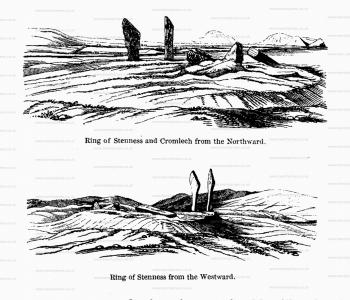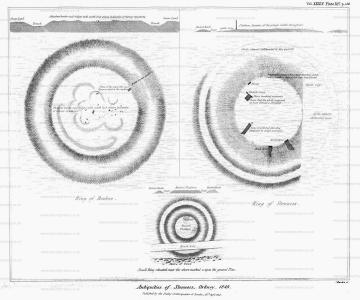Europe, British Isles, Scotland, Orkney Islands, Orkney, Ness of Brodgar, Stones of Stenness [Map]
Stones of Stenness is in Ness of Brodgar, Orkney Stone Circles.
3100BC. The Stones of Stenness [Map] is a Henge and Stone Circles erected around 3100BC based on radio-carbon dating; it isn't clear who undertook the dating? Aubrey Burl, in his book "A Guide to the Stone Circles of Britain, Ireland and Brittany", states "The setting [Stenness Type Cove] had consisted of three erect stones, two in line side by side, N-S, separated by a narrow gap behind which the third stood like the backstone of a chamber. It is a form of Cove./
Carbon Date. 2306BC. Early Bronze Age Carbon Dates
Report: Bone, id as animal, in ditch at Stenness [Map], Orkney, Scotland.
ID: 4672, C14 ID: SRR-350 Date BP: 4306 +/- 65, Start Date BP: 4241, End BP: 4371
OS Letter: HY, OS East: 306, OS North: 126
Archaeologist Name: J N G Ritchie
Reference Name: Discovery Excav Scot 1974, 79; Proc Scot Antiq Scot, 107, 1975-6 (1978), 1-60; A Burl, 'The stone circles of the British Isles' (1976) 46 and 101; C Renfrew (ed), 'The prehistory of Orkney' (1985) (synthesis etc)
Council for British Archaeology (2012) Archaeological Site Index to Radiocarbon Dates from Great Britain and Ireland [data-set]. York: Archaeology Data Service [distributor] https://doi.org/10.5284/1017767
Carbon Date. 2288BC. Early Bronze Age Carbon Dates
Report: Sample unspecified, from area around two stone-holes near centre of circle at Stenness [Map], Orkney, Scotland.
ID: 4673, C14 ID: SRR-351 Date BP: 4288 +/- 70, Start Date BP: 4218, End BP: 4358
OS Letter: HY, OS East: 306, OS North: 126
Archaeologist Name: J N G Ritchie
Reference Name: Discovery Excav Scot 1974, 79; Proc Scot Antiq Scot, 107, 1975-6 (1978), 1-60; A Burl, 'The stone circles of the British Isles' (1976) 46 and 101; C Renfrew (ed), 'The prehistory of Orkney' (1985) (synthesis etc)
Council for British Archaeology (2012) Archaeological Site Index to Radiocarbon Dates from Great Britain and Ireland [data-set]. York: Archaeology Data Service [distributor] https://doi.org/10.5284/1017767
Carbon Date. 1680BC. Middle Bronze Age Carbon Dates
Report: Wood from timber construction at Stenness [Map], Orkney, Scotland.
ID: 4674, C14 ID: SRR-592 Date BP: 3680 +/- 270, Start Date BP: 3410, End BP: 3950
OS Letter: HY, OS East: 306, OS North: 126
Archaeologist Name: J N G Ritchie
Reference Name: Discovery Excav Scot 1974, 79; Proc Scot Antiq Scot, 107, 1975-6 (1978), 1-60; A Burl, 'The stone circles of the British Isles' (1976) 46 and 101; C Renfrew (ed), 'The prehistory of Orkney' (1985) (synthesis etc)
Council for British Archaeology (2012) Archaeological Site Index to Radiocarbon Dates from Great Britain and Ireland [data-set]. York: Archaeology Data Service [distributor] https://doi.org/10.5284/1017767
Carbon Date. 569. Early Medieval
Report: Wood charcoal from Pit C at Stones of Stenness [Map], Orkney, Scotland. Comment [Ed]: Date lies within Migration period.
ID: 349, C14 ID: SRR-352 Date BP: 1431 +/- 150, Start Date BP: 1281, End BP: 1581
OS Letter: HY, OS East: 307, OS North: 125
Archaeologist Name: J N G Ritchie
Reference Name: Proc Soc Antiq Scot, 107, 1975-6 (1978), 50
Council for British Archaeology (2012) Archaeological Site Index to Radiocarbon Dates from Great Britain and Ireland [data-set]. York: Archaeology Data Service [distributor] https://doi.org/10.5284/1017767
Archaeologia Volume 34 1851 XIII Orkney Chapter II. The ruthless plough has been driven by barbarous men over this enduring record of the thoughts and labours of an exterminated people, and even within this century some of the pillars have been destroyed to clear the ground. The unlucky tenant of the adjoining farm has exercised his "little brief authority," and a most unenviable immortality has attached to him in consequence," for, "says Mr. Peterkin, "one (of the standing stones [Map]) has lately been thrown down; three were in the month of December, 1814, torn from the spot on which they had stood for ages, and were shivered to pieces." As Mr. Peterkin speaks rather apologetically for the man, he is not to be suspected of exaggeration; yet this statement does not correspond with the plates in Barry's History, nor the drawings of the late Marchioness of Stafford. At this moment there are two stones erect, and one prostrate, but perfect; and in the drawings referred to there are but four erect stones; hence the tenant of Barnhouse could have broken up but one of these stones (exclusive of the Odin Stone [Map]), and one he prostrated.
Archaeologia Volume 34 1851 XIII Orkney Chapter II. The lesser stone circle of Stenness, called here for the sake of distinction the Ring of Stenness [Map],b is a remarkable structure upon the low level point at the south side of the Bridge of Brogar, and, though considerably dilapidated, still presents sufficient of its original form to determine its dimensions without difficulty. It is indeed rather a matter of surprise that so much of it should be left for the delight of the antiquary, when it is considered that this ground has probably been under cultivation for nine hundred years. It is stated in Olaf Tryggvesson's Saga that one of the earls of Orkney was stopping at Stenness about A.D. 970; and I believe the site of the brû was not far from where the church at present stands, at least tradition says the palace stood there.
Note b. There is a ground plan and elevation of it in Plate XIV.


Archaeologia Volume 34 Section XIII. Account of some of the Celtic Antiquities of Orkney, including the Stones of Stenness [Map], Tumuli, Picts-houses, &c, with Plans, by F. W. L. Thomas (age 38), R.N., Corr. Mem. S.A. Scot., Lieutenant Commanding H.M. Surveying Vessel Woodlark. Read Feb. 6th and 13th, 1851.